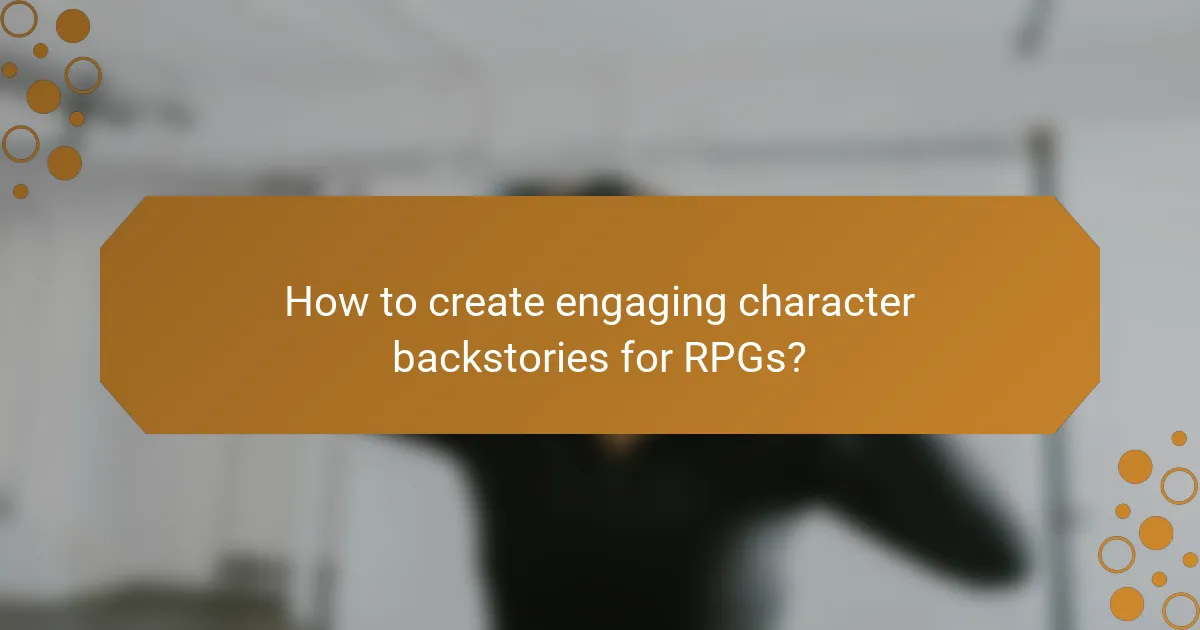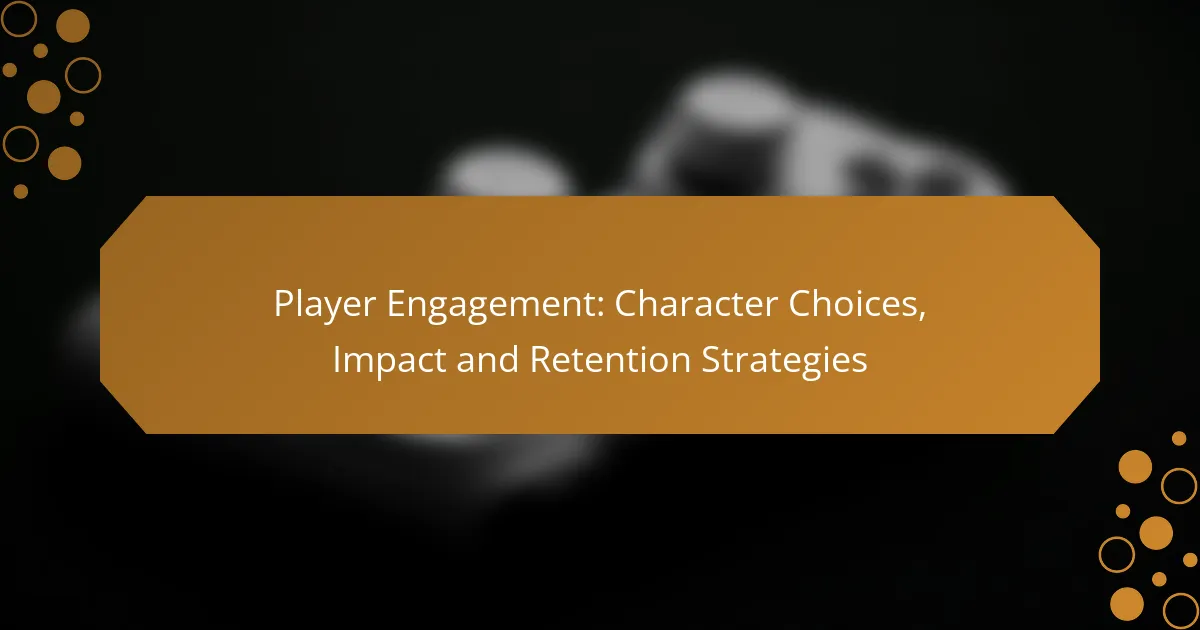Creating engaging character backstories for RPGs is crucial for enhancing player experience, as it weaves together depth, conflict, and meaningful connections. A well-developed backstory provides insight into a character’s motivations, relationships, and challenges, ultimately shaping their actions and decisions within the game. By incorporating conflict, characters become more relatable and complex, fostering a deeper connection with players.

How to create engaging character backstories for RPGs?
Creating engaging character backstories for RPGs involves blending depth, conflict, and player engagement. A well-crafted backstory not only enriches the character but also enhances the overall gaming experience by providing motivation and context.
Utilize character archetypes
Character archetypes serve as foundational templates that can guide backstory development. Common archetypes include the hero, mentor, rogue, and anti-hero, each with distinct traits and motivations. By aligning your character with an archetype, you can quickly establish their role in the story and their relationships with other characters.
However, avoid rigid adherence to archetypes; instead, use them as a springboard for creativity. For instance, a hero might have unexpected flaws or a mentor could harbor dark secrets, adding complexity and intrigue.
Incorporate personal conflicts
Personal conflicts are essential for creating depth in a character’s backstory. These conflicts can be internal, such as struggling with guilt or fear, or external, like a rivalry or family feud. By introducing these challenges, you give players a reason to invest emotionally in the character’s journey.
Consider using conflicts that resonate with the game’s themes. For example, in a fantasy setting, a character might grapple with their loyalty to a corrupt kingdom versus their desire for justice. This creates a compelling narrative that can evolve throughout the campaign.
Develop rich histories
A character’s history shapes their identity and motivations. Include key events from their past, such as formative experiences, significant losses, or pivotal moments that define who they are. These elements should be woven into the backstory to create a cohesive narrative.
For example, a character who lost their family to a dragon attack might seek revenge, driving their actions in the game. Ensure that the history is detailed enough to be engaging but flexible enough to allow for character growth during gameplay.
Integrate player choices
Involving players in the backstory creation process can lead to more engaging narratives. Allow players to make choices that influence their character’s past, such as selecting a mentor or deciding how they responded to a traumatic event. This investment fosters a deeper connection to the character.
Consider using a collaborative approach during character creation sessions. This not only enriches the backstory but also encourages players to explore their character’s motivations and relationships in the game world.
Use narrative hooks
Narrative hooks are intriguing elements that grab the players’ attention and draw them into the character’s story. These can be mysteries, unresolved issues, or unique traits that prompt questions and exploration. A well-placed hook can motivate players to engage more deeply with the character’s journey.
For instance, a character with a mysterious birthmark might be linked to an ancient prophecy, enticing players to uncover its significance. Ensure that these hooks are relevant to the overarching plot and can evolve as the story progresses.

What are the key elements of character backstory?
Character backstory is essential for creating depth and engagement in storytelling. Key elements include motivation and goals, relationships and connections, traumas and challenges, as well as skills and abilities, all of which shape a character’s actions and decisions.
Motivation and goals
Motivation and goals drive a character’s actions and decisions throughout the narrative. Understanding what a character wants—whether it’s revenge, redemption, or love—helps to create a compelling arc. For example, a character seeking vengeance might take risks that lead to conflict, while one pursuing peace may avoid confrontation.
When developing motivations, consider both short-term and long-term goals. Short-term goals can create immediate tension, while long-term aspirations can provide a broader context for the character’s journey. Ensure that these goals are relatable and grounded in the character’s experiences.
Relationships and connections
Relationships and connections significantly influence a character’s development and choices. These can include family ties, friendships, or rivalries that shape the character’s worldview. For instance, a character with a supportive mentor may exhibit confidence, while one with a toxic relationship might struggle with self-doubt.
Establishing clear dynamics between characters can enhance emotional engagement. Consider how these relationships evolve over time and how they impact the character’s motivations and decisions. Strong connections can create compelling conflicts and resolutions within the story.
Traumas and challenges
Traumas and challenges add complexity to a character’s backstory, revealing vulnerabilities and strengths. Past experiences, such as loss or betrayal, can deeply affect a character’s behavior and outlook. For example, a character who has faced significant hardship may be more resilient or, conversely, more guarded.
Incorporating challenges can also provide opportunities for growth. Characters who confront their traumas can experience transformation, making their journeys more relatable and inspiring. Ensure that these elements are woven into the narrative to enhance depth and authenticity.
Skills and abilities
Skills and abilities define what a character can do and how they interact with the world. These can range from physical skills, like combat or athletics, to intellectual abilities, such as problem-solving or negotiation. A character’s skills often align with their motivations and can be pivotal in overcoming challenges.
When developing skills, consider how they relate to the character’s backstory and experiences. For instance, a character raised in a military family may have combat training, while one from a scholarly background might excel in strategy. Balancing strengths and weaknesses can create a more nuanced and engaging character.

How does conflict enhance character depth?
Conflict is essential for adding depth to characters, as it reveals their motivations, fears, and growth. Through challenges and struggles, characters become more relatable and complex, allowing players to connect with them on a deeper level.
Creates tension and stakes
Conflict introduces tension and stakes, making the narrative more engaging. When characters face obstacles, the potential consequences of their actions become clearer, heightening the drama and urgency of the story.
For example, a character might be torn between loyalty to a friend and the need to protect their community. This internal struggle creates a compelling scenario that keeps players invested in the outcome.
Drives character development
Conflict is a catalyst for character development, pushing individuals to confront their flaws and evolve. As characters navigate challenges, they often discover new strengths or reconsider their beliefs, leading to significant personal growth.
A character who starts as a coward may find courage when faced with a dire situation, transforming into a hero by the story’s end. This evolution not only enriches the character but also enhances the overall narrative arc.
Facilitates player engagement
Conflict enhances player engagement by creating emotional investment in the characters’ journeys. Players are more likely to care about outcomes when they see characters grappling with meaningful dilemmas.
Designers can facilitate this engagement by presenting players with choices that reflect the characters’ conflicts, allowing them to influence the story. This interactivity deepens the connection between players and characters, making the experience more immersive.

What frameworks can guide backstory development?
Frameworks for backstory development help create depth and conflict in characters, enhancing player engagement. Utilizing structured models and storytelling techniques can lead to more compelling narratives and relatable characters.
Character development models
Character development models provide a systematic approach to building a character’s backstory. The Hero’s Journey, for example, outlines stages that a character typically undergoes, such as the call to adventure and the ultimate return. This model can help identify key moments in a character’s past that shape their motivations and conflicts.
Another effective model is the Five Elements of Character, which includes traits, desires, fears, flaws, and backstory. By analyzing these elements, writers can create multi-dimensional characters that resonate with players. Consider using a simple checklist to ensure each element is addressed: traits (what defines them), desires (what they want), fears (what they avoid), flaws (what holds them back), and backstory (where they come from).
Storytelling techniques
Storytelling techniques enhance the delivery of a character’s backstory, making it more engaging. Flashbacks are a popular method, allowing players to experience pivotal moments in a character’s life, thus creating emotional connections. Use them sparingly to maintain pacing and avoid overwhelming players with information.
Another technique is the use of dialogue to reveal backstory organically. Characters can share their past through conversations, making the information feel more natural and integrated into the narrative. Aim for balance; too much exposition can detract from the flow of the story.

How to integrate backstories into gameplay?
Integrating character backstories into gameplay enhances player engagement by creating emotional connections and driving narrative depth. This can be achieved through various techniques that allow players to explore their characters’ histories and motivations during the game.
Use flashbacks and memories
Flashbacks and memories provide players with immersive experiences that reveal their character’s past. Implementing these moments can be done through cutscenes or interactive sequences that allow players to relive significant events.
Consider using flashbacks sparingly to maintain their impact. A good rule of thumb is to include them at pivotal moments, such as during a character’s decision-making process or when facing a related challenge.
Incorporate NPC interactions
Non-player characters (NPCs) can serve as vital links to a character’s backstory. By creating NPCs who have connections to the character’s past, you can facilitate meaningful conversations that reveal history and motivate current actions.
Design NPCs with distinct personalities and relevant knowledge about the character’s past. This can include former allies, rivals, or family members, each providing unique insights that can deepen the player’s understanding of their character.
Design quests around backstories
Quests that are closely tied to a character’s backstory can significantly enhance player engagement. These quests should reflect the character’s history, motivations, and unresolved conflicts, making the gameplay feel personal and relevant.
When designing such quests, ensure they offer choices that reflect the character’s values and past experiences. For example, a quest could involve confronting a former enemy or retrieving a lost heirloom, allowing players to explore their character’s emotional journey while progressing in the game.

What tools can assist in backstory creation?
Several tools can enhance backstory creation by providing structure and inspiration. These tools range from character questionnaires to software designed specifically for world-building and narrative development.
Character Questionnaires
Character questionnaires help flesh out a character’s background by prompting creators to consider various aspects of their lives. Questions may cover family history, significant life events, and personal motivations. This structured approach can reveal conflicts and depth that enhance player engagement.
For example, a questionnaire might ask about a character’s biggest regret or their greatest achievement. These insights can inform how a character reacts in different scenarios, making them more relatable and engaging for players.
World-Building Software
World-building software provides a platform for organizing and visualizing a character’s backstory within a broader context. Tools like World Anvil or Scrivener allow creators to map out timelines, relationships, and key events that shape a character’s identity. This can lead to richer narratives and deeper player immersion.
Using such software, creators can easily track how a character’s past influences their current decisions, ensuring consistency in storytelling. This is particularly useful in complex campaigns where multiple characters interact and share histories.
Collaborative Storytelling Platforms
Collaborative storytelling platforms enable multiple players to contribute to a character’s backstory, fostering a shared narrative experience. Tools like Roll20 or Discord can facilitate discussions and brainstorming sessions, allowing players to co-create histories that resonate with everyone involved.
By engaging in collaborative backstory development, players can explore different perspectives and deepen their connections to the narrative. This approach often leads to unexpected plot twists and character developments that enhance the overall gaming experience.



